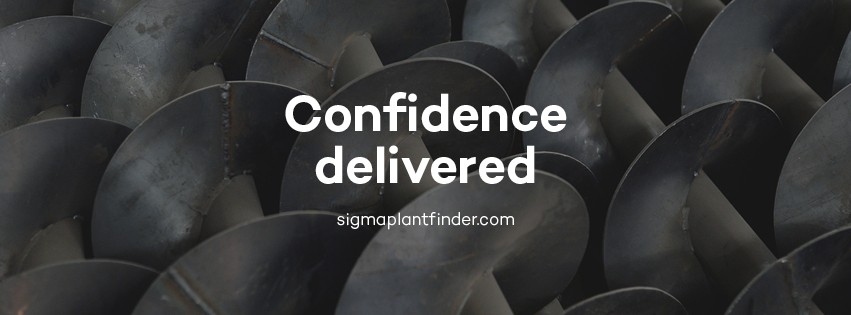
Mini Piling rigs come it a number of different types for various applications. Here at Sigma Plantfinder Limited we aim to make things as easy as possible for you, below we have set out some basic information on the main types of mini Piling for your help and information.
Mini Piles, also called Micro Piles, soil nailing, drifter drilling, and Geotechnical soil investigation are typically constructed using smaller machines than regular Bored and Continuous Flight Auger (CFA) Piles and are often used for underpinning and restricted access jobs. They can also be used for foundations for project types including highway, bridge and transmission tower projects or on commercial and domestic developments in cities and built up areas and at sites with difficult or restricted access or with environmental sensitivity.
The main types of Mini Piles are achieved using drilling, impact driving or screwing mini piling rigs. The difference of mini piles from other pile types has more to do with how and where they are installed than just the pile size alone.
10 Advantages of mini piling:
- Mini Piles are speedy to install, depending on ground conditions.
- They usually work very well both in tension and compression situations.
- Mini piling causes minimal disturbance and vibration to near other structures or buildings during the installation of them.
- Depending on suitable ground conditions they can be installed in a cost-effective way, with high load bearing capacities.
- Greater depths can be achieved with ease providing a solid lasting foundation.
- Mini piling systems enable engineers and builders to fabricate extensions to homes in tight confined spaces that would have been out of bounds otherwise.
- They can be incorporated structurally into foundation systems that are already existing.
- Work can be carried out within low headroom situations and in restricted access working conditions.
- Mini piles use less concrete and steel than other piling systems, therefore reducing the foundation carbon footprint and overall costs.
- Mini Piles are a good solution for sites with environmental sensitivity or in close proximity to other buildings.

Methods of Mini Piling
Mini Piles can be installed using different techniques dependent on the conditions and requirements of the project or of the ground conditions.
Mini piling rigs can work in sites subject to both width and height restrictions.
Mini Piles may be steel driven tubes, or bored cast in-situ concrete.
There are various techniques of mini piling which include;
Sectional Flight Auger (SFA) piling – this technique is used where there is low head room or on very restricted job sites where you are not able to use a larger CFA rig. These piles are made by using lengths of hollow stem sectional continuous flight auger. SFA can be used in all unobstructed ground conditions including made up ground and ground with high water tables. Due to the small size of the rigs used they are ideal for where there is restricted access or a low working height.
Augered Piling is often used in cohesive soils where segmental augers are screwed into the ground and the soil is flighted to the surface by the augers. Where there is unstable ground, temporary casings can be installed in conjunction with the augers to help the process. When the desired pile depth has been reached, the steel reinforcement is placed in the hole, and the pile bore is filled with either grout or concrete. This type of pile can also be filled with concrete through the centre of the augers as they are retracted. This technique is very time efficient and cost effective where open boring is possible.
Mini Bottom-Driven Piling - efficient and suitable for most ground conditions. A closed-ended thin walled steel tube is driven in short lengths using an internal drop hammer on to a dry concrete plug. The tubes are joined by a full non-structural fillet weld and as the installation proceeds the pile is driven to a predetermined set length. Once the required depth is reached the tube is filled with high slump concrete or grout and a single bar or cage is inserted for reinforcement.
Bottom Driven Steel Cased & Top Driven Steel/Precast - Used within restricted areas for poor ground conditions, where deep foundations are impracticable. Applications include extensions to homes, one-off housing plots, machine bases and mezzanine floors. They can offer a high load capacity and can overcome harder driving conditions.
Open Hole Auger - Used in ground conditions where heave may be a possibility but where the ground conditions allow the pile bore to stay open. A liner can be installed to a designed depth to minimise heave. Temporary casings can be used to support ground that may be unstable near the top of the pile. This method of piling allows the pile to be filled with concrete from the top as the casings are removed.
DTH Open Hole Drilling - Used for drilling into un-reinforced concrete and rock. Can also be used when the overburden drilling has reached Rock. These rigs are smaller in size compared to the driven precast piling rigs and provide more flexibility on getting into restricted access sites. They are also used extensively for Water Well Drilling and construction of water wells.
Further Information:
Here at Sigma Plantfinder Limited we have for sale a vast selection of used Mini Piling rigs, along with all other kinds of piling rigs like CFA Piling rigs, Rotary Piling rigs, Hammer Piling rigs, Jet Grouting, Vibro and Sheet Piling rigs and Diaphragm Wall piling rigs.
Our selection of Mini Piling rigs will ensure you can select the correct machine for the job, this will mean you can provide the most competitive quote for mini piles which fits the project and budget at hand.
Contact Sigma Plantfinder today to discuss your piling and drilling needs.
